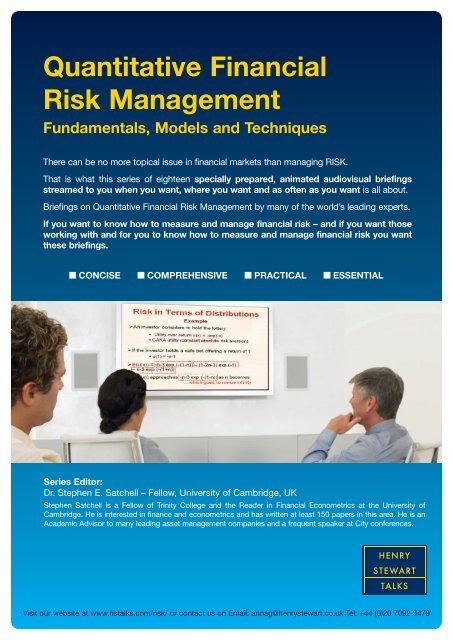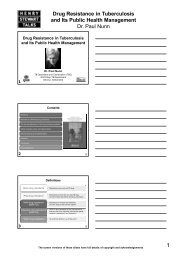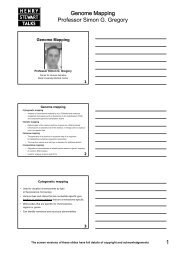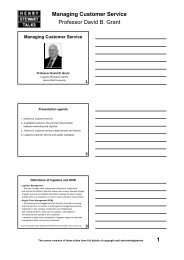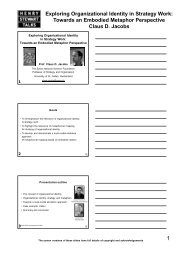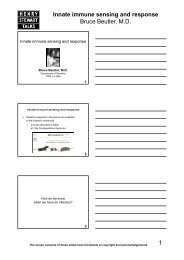Quantitative Financial Risk Management - Henry Stewart Talks
Quantitative Financial Risk Management - Henry Stewart Talks
Quantitative Financial Risk Management - Henry Stewart Talks
You also want an ePaper? Increase the reach of your titles
YUMPU automatically turns print PDFs into web optimized ePapers that Google loves.
<strong>Quantitative</strong> <strong>Financial</strong><br />
<strong>Risk</strong> <strong>Management</strong><br />
Fundamentals, Models and Techniques<br />
There can be no more topical issue in financial markets than managing RISK.<br />
That is what this series of eighteen specially prepared, animated audiovisual briefings<br />
streamed to you when you want, where you want and as often as you want is all about.<br />
Briefings on <strong>Quantitative</strong> <strong>Financial</strong> <strong>Risk</strong> <strong>Management</strong> by many of the world’s leading experts.<br />
If you want to know how to measure and manage financial risk – and if you want those<br />
working with and for you to know how to measure and manage financial risk you want<br />
these briefings.<br />
■ CONCISE ■ COMPREHENSIVE ■ PRACTICAL ■ ESSENTIAL<br />
Series Editor:<br />
Dr. Stephen E. Satchell – Fellow, University of Cambridge, UK<br />
Stephen Satchell is a Fellow of Trinity College and the Reader in <strong>Financial</strong> Econometrics at the University of<br />
Cambridge. He is interested in finance and econometrics and has written at least 150 papers in this area. He is an<br />
Academic Advisor to many leading asset management companies and a frequent speaker at City conferences.<br />
Visit our website at www.hstalks.com/risk/ or contact us on Email: annag@henrystewart.co.uk Tel: +44 (0)20 7092 3479
<strong>Quantitative</strong> <strong>Financial</strong> <strong>Risk</strong> <strong>Management</strong><br />
Specially prepared, animated, audiovisual briefings by leading experts from industry and academia;<br />
available when you want, where you want and as often as you want.<br />
Available on individual user license for $2500 (£1515, €1775) and on site license for $4999 (£2999,<br />
€3550) giving unlimited access for all members of an organization within a single country.<br />
To purchase the series complete and return order form on page 6.<br />
I: INTRODUCTORY REVIEWS<br />
1. Practical use of portfolio risk management<br />
today<br />
Definitions of risk management (RM) in different contexts –<br />
Practical application rather than theory – Does RM make a<br />
major contribution to portfolio safety – Can RM exacerbate<br />
adverse markets – The impacts of regulatory risk on fund<br />
managers – Appropriate or mistargeted – How is risk forecast<br />
and how does that feed into the investment process – Do<br />
quantitative techniques add value or lower risk – <strong>Risk</strong><br />
strategies: how to measure, implement and control<br />
Mr. Daryl Roxburgh – Head, BITA <strong>Risk</strong> Solutions, UK and<br />
USA<br />
Daryl Roxburgh is Head of BITA <strong>Risk</strong> Solutions, the London and<br />
New York based portfolio construction and risk solutions<br />
provider. Daryl is a graduate of the City University (now John<br />
Cass) Business School and his career commenced as a private<br />
client fund manager with Buckmaster & Moore. He progressed<br />
to a senior management role in 1987 and was subsequently<br />
appointed Director of IT in 1994 for Credit Suisse Asset<br />
<strong>Management</strong>. Following two years at M&G, he was recruited by<br />
Prudential Portfolio Managers as Global Head of IT in 1998. He<br />
now specializes in portfolio construction and risk analysis<br />
solutions for the quantitative, institutional and private banking<br />
markets.<br />
2. Statistical models for risk management<br />
Definition of returns: simple returns and log returns –<br />
Distribution of returns, univariate: normal and log-normal<br />
distribution – Stylized facts of historical returns – Skewness,<br />
kurtosis, autocorrelation and stationarity – ARCH, GARCH and<br />
stochastic volatility (SV) models – Distribution of returns,<br />
multivariate: multivariate normal distribution – Multivariate<br />
GARCH and SV models – Copulas and non-linear dependence<br />
Prof. John Knight – Professor of Economics, University of<br />
Western Ontario, Canada<br />
John Knight received his PhD from the University of New South<br />
Wales, Australia in 1980. He has held teaching and research<br />
positions in the US, Australia, UK and Canada and has been in<br />
his current position since 1987. His extensive list of research<br />
publications are in theoretical econometrics and more recently<br />
in financial econometrics. In 2002 he was awarded a Plura<br />
Scripsit Award by the journal Econometric Theory. He has also<br />
won awards for his graduate teaching and PhD supervision.<br />
Current research interests include stochastic volatility modeling<br />
and the estimation of continuous time processes in finance.<br />
3. Utility theory and mean variance<br />
Expected utility representation of preferences – Rationality<br />
criteria – State independent utility – <strong>Risk</strong> averse behavior – <strong>Risk</strong><br />
and insurance premium – Arrow-Pratt’s absolute risk aversion<br />
coefficient – <strong>Risk</strong> aversion and small risk – Relative risk<br />
aversion coefficient – <strong>Risk</strong> tolerance – CARA utility – CRRA<br />
utility – <strong>Risk</strong> aversion and large risk – Utility and variance<br />
measures of risk – Variance aversion and two fund separation –<br />
Local risk neutrality – Marginal utility and two fund separation –<br />
Factor structure and two fund separation<br />
Dr. Norvald Instefjord – Reader in Finance, University of<br />
Essex, UK<br />
Norvald is a Reader in Finance and an Associate Director of<br />
Finance Studies at the Department of Accounting, Finance and<br />
<strong>Management</strong> at the University of Essex. He received a PhD in<br />
finance from the London Business School in 1995 and was a<br />
Lecturer in Finance at Birkbeck College, University of London,<br />
from 1994 to 2004. Norvald’s primary research interests are<br />
corporate finance (including disclosure and corporate<br />
governance issues), banking (including risk management and<br />
issues linked to fraud and operational risk), and security and<br />
market design. He also has extensive teaching experience in<br />
general and corporate finance, mathematical and theoretical<br />
finance and market microstructure.<br />
4. Definitions of risk<br />
Distributional properties of risk – Variance – <strong>Risk</strong> aversion and<br />
variance aversion – First order stochastic dominance – Second<br />
order stochastic dominance – Axiomatic approach to risk<br />
measures – <strong>Risk</strong> as a choice variable – Acceptable and nonacceptable<br />
risk – Single-dimensional risk measures – <strong>Risk</strong><br />
measure and risk capital – Coherent risk measures – Value-atrisk<br />
(VaR) is not coherent – TailVaR and worst conditional<br />
expectations – Rotschild/Stiglitz increasing risk – Conclusions:<br />
risk definition depends on context and purpose<br />
Dr. Norvald Instefjord – Reader in Finance, University of<br />
Essex, UK<br />
Norvald is a Reader in Finance and an Associate Director of<br />
Finance Studies at the Department of Accounting, Finance and<br />
<strong>Management</strong> at the University of Essex. He received a PhD in<br />
finance from the London Business School in 1995 and was a<br />
Lecturer in Finance at Birkbeck College, University of London,<br />
from 1994 to 2004. Norvald’s primary research interests are<br />
corporate finance (including disclosure and corporate<br />
governance issues), banking (including risk management and<br />
issues linked to fraud and operational risk), and security and<br />
market design. He also has extensive teaching experience in<br />
general and corporate finance, mathematical and theoretical<br />
finance and market microstructure.
<strong>Quantitative</strong> <strong>Financial</strong> <strong>Risk</strong> <strong>Management</strong><br />
5. Volatility<br />
Volatility is the most heavily used measure of risk in financial<br />
decision making – Discussion of validity of various measures of<br />
risk – Statement of conditions under which volatility is a good<br />
measure – Explanation of the empirical properties of data and<br />
their dynamics – Why models need to capture these<br />
characteristics – Analysis of various approaches of volatility<br />
estimation with particular emphasis on dynamic models in both<br />
univariate and multivariate contexts – Techniques for volatility<br />
model validation – Explanation of possible pitfalls – Out-ofsample<br />
volatility forecasting using dynamic models and various<br />
methods for volatility forecast evaluation<br />
Dr. George A. Christodoulakis – Assistant Professor of<br />
Finance, University of Manchester, UK and Advisor, Bank of<br />
Greece, Greece<br />
George A. Christodoulakis is Assistant Professor of Finance at<br />
Manchester Business School, University of Manchester and<br />
Advisor at the Bank of Greece. In the past he has held<br />
positions at Cass Business School of City University, London<br />
and the University of Exeter and has provided advice for a<br />
number of companies. He holds a PhD and MSc in finance<br />
from the University of London as well as an MSc and BSc in<br />
economics and econometrics from the AUEB in Athens. His<br />
expertise concerns the area of credit and market risk theory<br />
and applications, approached from both a mathematical<br />
finance and a financial econometrics perspective. George is a<br />
regular contributor to international refereed research journals<br />
and a frequent speaker in specialist conferences.<br />
6. Hedge fund risk assessment<br />
Environmental scan/allocation strategies – Discerning how<br />
alpha is generated – Criteria for hedge fund success –<br />
Evaluating returns – Warning signs to monitor – Portfolio<br />
considerations<br />
Mr. David Martin – Senior Vice President and Chief <strong>Risk</strong><br />
Officer, AllianceBernstein L.P., USA<br />
David Martin is Senior Vice President and Chief <strong>Risk</strong> Officer of<br />
AllianceBernstein LP. Mr. Martin joined the firm in December<br />
2001 and is responsible for the risk management function. Mr.<br />
Martin began his career at Price Waterhouse & Co in 1972 in<br />
the audit and consulting practices. In 1979 he joined Citibank<br />
and held numerous positions during his 20-year tenure. Mr.<br />
Martin was a Senior <strong>Risk</strong> Officer responsible for the global<br />
windows on risk processes that were used to proactively<br />
manage the entire risk profile of Citigroup. From 1999-2001, Mr.<br />
Martin was an active Director of DFD Select Group, a manager<br />
and distributor of funds of hedge funds.<br />
II: PORTFOLIO RISK<br />
7. The structure of equity risk models<br />
Stock risk models for portfolio risk analysis – Generic risk<br />
model data – Betas and covariances – Two significant choices<br />
about structure and their consequences for estimation error –<br />
The impact on portfolio risk forecasts – A short digression on<br />
stock selection – Choosing factors<br />
Mr. Jason MacQueen – Chairman, Alpha Strategies, LLC, UK<br />
Jason MacQueen founded QUANTEC in 1980, which was the first<br />
firm to develop risk models for equity markets outside the USA. In<br />
1984 QUANTEC launched the first global asset allocation model,<br />
which was enhanced in 1985 by the addition of currency hedging<br />
overlays and in 1986 by reverse optimization for efficient portfolio<br />
rebalancing. Jason also pioneered the development and use of<br />
multi-factor stock selection models in both the USA and Japan<br />
and the investment track record of his long-term collaborators is<br />
exceptional. In the late 1990s he helped to develop the first truly<br />
global risk model and a global stock selection model, both<br />
incorporating global common factors. He is currently working<br />
with R-Squared to develop customized hybrid risk models for<br />
institutional investors and with Apollo Advisors, which uses a<br />
proprietary risk overlay system to manage a fund of funds and<br />
optimize the portfolio risk-return trade-off.<br />
8. <strong>Risk</strong> decomposition (and risk budgeting)<br />
The standard method of decomposing portfolio risk into<br />
contributions from individual assets – ‘<strong>Risk</strong> budgeting’ by<br />
pension funds – Unfortunately, while this analysis gives a<br />
unique answer for absolute risk, it gives three very different<br />
answers for tracking error, or risk relative to some benchmark<br />
(such as the pension fund’s liabilities) – Description of what is<br />
happening – Analysis used by most practitioners does not give<br />
the most useful answer<br />
Mr. Jason MacQueen – Chairman, Alpha Strategies, LLC, UK<br />
Jason MacQueen founded QUANTEC in 1980, which was the<br />
first firm to develop risk models for equity markets outside the<br />
USA. In 1984 QUANTEC launched the first global asset<br />
allocation model, which was enhanced in 1985 by the addition<br />
of currency hedging overlays and in 1986 by reverse<br />
optimization for efficient portfolio rebalancing. Jason also<br />
pioneered the development and use of multi-factor stock<br />
selection models in both the USA and Japan and the<br />
investment track record of his long-term collaborators is<br />
exceptional. In the late 1990s he helped to develop the first<br />
truly global risk model and a global stock selection model, both<br />
incorporating global common factors. He is currently working<br />
with R-Squared to develop customized hybrid risk models for<br />
institutional investors and with Apollo Advisors, which uses a<br />
proprietary risk overlay system to manage a fund of funds and<br />
optimize the portfolio risk-return trade-off.<br />
III: MARKET RISK<br />
9. Estimating risk models<br />
Defining a risk model – Assembling data – Non-parametric<br />
estimation methods – Parametric estimation methods – Monte<br />
Carlo simulation methods<br />
Prof. Kevin Dowd – Professor of <strong>Financial</strong> <strong>Risk</strong><br />
<strong>Management</strong>, Nottingham University, UK<br />
Kevin Dowd is Professor of <strong>Financial</strong> <strong>Risk</strong> <strong>Management</strong> at<br />
Nottingham University Business School, where he works with<br />
the Center for <strong>Risk</strong> and Insurance Studies. His research<br />
interests cover macro, monetary and financial economics,<br />
financial risk management, insurance, pensions and political<br />
economy. His latest book, Measuring Market <strong>Risk</strong> (2nd edition)<br />
was published by John Wiley in 2005.
<strong>Quantitative</strong> <strong>Financial</strong> <strong>Risk</strong> <strong>Management</strong><br />
10. Measures of financial risk<br />
Nature of financial risk – Representing financial risk using a<br />
density function – VaR as a risk measure – Expected shortfall –<br />
Coherent risk measures – Worst-case scenario analyses<br />
Prof. Kevin Dowd – Professor of <strong>Financial</strong> <strong>Risk</strong><br />
<strong>Management</strong>, Nottingham University, UK<br />
Kevin Dowd is Professor of <strong>Financial</strong> <strong>Risk</strong> <strong>Management</strong> at<br />
Nottingham University Business School, where he works with<br />
the Center for <strong>Risk</strong> and Insurance Studies. His research<br />
interests cover macro, monetary and financial economics,<br />
financial risk management, insurance, pensions and political<br />
economy. His latest book, Measuring Market <strong>Risk</strong> (2nd edition)<br />
was published by John Wiley in 2005.<br />
11. VaR when volatility is changing<br />
What can we learn from problems with VaR models –<br />
Common patterns in volatility (the clustering effect) –<br />
Forecasting volatility using GARCH – Implications for VaR,<br />
stress testing and capital requirements<br />
Dr. Elizabeth Sheedy – Associate Professor, Macquarie<br />
Applied Finance Center, Macquarie University, Australia<br />
Elizabeth Sheedy joined Macquarie University in 1993. Prior to<br />
this she worked in the finance industry for institutions including<br />
Macquarie Bank and Westpac. She now teaches financial risk<br />
management courses in the popular master of applied finance<br />
program. Her current research focus is on volatility clustering<br />
and its application to modeling market risk. She is also on the<br />
Academic Advisory Committee for the Professional <strong>Risk</strong><br />
Managers’ International Association (PRMIA). She co-edited the<br />
Professional <strong>Risk</strong> Managers’ Guides recently published by<br />
McGraw-Hill.<br />
IV: APPLICATIONS TO CREDIT RISK AND<br />
MARKET RISK<br />
12. Structural and reduced form models<br />
Structural models – The Merton approach: bond pricing, stock<br />
pricing, default probability, credit spreads, bond volatility –<br />
Parameter estimation – Limitations – Extending Merton: the<br />
CreditGrades model reduced form models – Default intensity –<br />
Examples: constant, deterministic and stochastic intensities –<br />
Linking reduced and structural models – Recovery rates<br />
Dr. Theo Darsinos – Associate Director, Fixed Income<br />
Trading, Barclays Capital, UK<br />
Theo Darsinos is an Associate Director of Fixed Income Trading<br />
at Barclays Capital. Prior to this he was a Vice President in the<br />
global markets, fixed income research division of Deutsche<br />
Bank. Theo received his PhD in financial econometrics from the<br />
University of Cambridge and a BSc in mathematics from the<br />
University of London. Prior to joining Deutsche Bank in 2003,<br />
he was a Research Fellow in the Department of Applied<br />
Economics, University of Cambridge.<br />
13. Modeling business dependencies for credit<br />
portfolios<br />
Portfolio credit risk – Integrating macrostructural and<br />
microstructural interdependencies – Gaussian copula – Credit<br />
portfolio as a graph – Impact of business dependencies on<br />
correlation – Feedback effects – Marginal risk contribution<br />
Dr. Markus A. Leippold – Assistant Professor, Swiss<br />
Banking Institute, University of Zurich, Switzerland<br />
Markus Leippold is Assistant Professor of Finance at the Swiss<br />
Banking Institute of the University of Zurich. Prior to moving<br />
back to academia he was working for Sungard, Trading and<br />
<strong>Risk</strong> <strong>Management</strong> Systems and the Zurich Cantonal Bank.<br />
Markus’ main research interests are term structure modeling,<br />
asset pricing and risk management. He was a Research Fellow<br />
at the Stern School of Business in New York and obtained his<br />
PhD from the University of St. Gallen, Switzerland, in 1999. He<br />
has published in several Journals such as Journal of <strong>Financial</strong><br />
and <strong>Quantitative</strong> Analysis, Journal of Economic Dynamics and<br />
Control, Journal of Banking and Finance, Review of Derivative<br />
Research, Journal of <strong>Risk</strong>, Journal of Futures Markets and<br />
Review of Finance. In 2004, the research paper he co-authored<br />
on credit contagion won the STOXX Gold Award at the annual<br />
conference of the European <strong>Financial</strong> <strong>Management</strong><br />
Association. During 2005, he was a Visiting Researcher at the<br />
Federal Reserve Bank in New York.<br />
14. Extreme value theory and copulas<br />
Extremes in quantitative risk management – Limiting behavior<br />
of sums and maxima – Fisher/Tippett theorem – Extreme value<br />
distributions and domains of attraction – Block maxima method<br />
– Threshold exceedances – Picands/Balkema/de Haan theorem<br />
– Threshold selection – Quantile estimation – Point process<br />
approach – Banking and insurance regulation – Critical<br />
appraisal<br />
Prof. Paul Embrechts – Professor of Mathematics, Swiss<br />
Federal Institute of Technology, Switzerland<br />
Paul Embrechts is Professor of Mathematics at ETH Zurich<br />
specializing in actuarial mathematics and quantitative risk<br />
management. Previous academic positions include the<br />
Universities of Leuven, Limburg and London (Imperial College).<br />
Prof. Embrechts has held visiting appointments at the<br />
University of Strasbourg, ESSEC Paris, the Scuola Normale in<br />
Pisa and the London School of Economics (Centennial<br />
Professor of Finance). He is an Elected Fellow of the Institute of<br />
Mathematical Statistics, Honorary Fellow of the Institute of<br />
Actuaries, corresponding member of the Italian Institute of<br />
Actuaries and Associate Editor of numerous journals. His areas<br />
of specialization include insurance risk theory, quantitative risk<br />
management, the interplay between insurance and finance and<br />
the modeling of rare events. He co-authored the influential<br />
books Modelling of Extremal Events for Insurance and Finance,<br />
Springer, 1997 and <strong>Quantitative</strong> <strong>Risk</strong> <strong>Management</strong>: Concepts,<br />
Techniques and Tools, Princeton University Press, 2005.<br />
Dr. Johanna Neslehova – Postdoctoral Research Fellow,<br />
Swiss Federal Institute of Technology, Switzerland<br />
Johanna Neslehova is currently a Postdoctoral Research Fellow<br />
at the risk management research centre <strong>Risk</strong>Lab, ETH Zurich.<br />
She completed her PhD on dependence of non-continuous<br />
random variables with Professor Dietmar Pfeifer at the<br />
University of Oldenburg in 2004. Her research interests include<br />
stochastic methods for quantitative risk management in
<strong>Quantitative</strong> <strong>Financial</strong> <strong>Risk</strong> <strong>Management</strong><br />
finance, dependence modeling, discrete copulas, point<br />
processes, extreme value theory and operational risk. She has<br />
spoken at various conferences on risk management. She is<br />
involved in the German e-learning project EStat and wrote a<br />
book on elementary mathematics with Erhard Cramer<br />
published by Springer in 2004.<br />
15. Dependence modeling with copulas<br />
Impact of extremes and dependence in finance and insurance –<br />
Correlation issues – Copulas and Sklar’s theorem – Copula<br />
generation – Frechet-Hoeffding bounds – Limitations of<br />
correlation – Rank correlation measures – An application to<br />
credit risk – Tail dependence – Bounds on risk measures –<br />
Critical appraisal<br />
Prof. Paul Embrechts – Professor of Mathematics, Swiss<br />
Federal Institute of Technology, Switzerland<br />
Paul Embrechts is Professor of Mathematics at ETH Zurich<br />
specializing in actuarial mathematics and quantitative risk<br />
management. Previous academic positions include the<br />
Universities of Leuven, Limburg and London (Imperial College).<br />
Prof. Embrechts has held visiting appointments at the<br />
University of Strasbourg, ESSEC Paris, the Scuola Normale in<br />
Pisa and the London School of Economics (Centennial<br />
Professor of Finance). He is an Elected Fellow of the Institute of<br />
Mathematical Statistics, Honorary Fellow of the Institute of<br />
Actuaries, corresponding member of the Italian Institute of<br />
Actuaries and Associate Editor of numerous journals. His areas<br />
of specialization include insurance risk theory, quantitative risk<br />
management, the interplay between insurance and finance and<br />
the modeling of rare events. He co-authored the influential<br />
books Modelling of Extremal Events for Insurance and Finance,<br />
Springer, 1997 and <strong>Quantitative</strong> <strong>Risk</strong> <strong>Management</strong>: Concepts,<br />
Techniques and Tools, Princeton University Press, 2005.<br />
Dr. Johanna Neslehova – Postdoctoral Research Fellow,<br />
Swiss Federal Institute of Technology, Switzerland<br />
Johanna Neslehova is currently a Postdoctoral Research Fellow<br />
at the risk management research centre <strong>Risk</strong>Lab, ETH Zurich.<br />
She completed her PhD on dependence of non-continuous<br />
random variables with Professor Dietmar Pfeifer at the<br />
University of Oldenburg in 2004. Her research interests include<br />
stochastic methods for quantitative risk management in<br />
finance, dependence modeling, discrete copulas, point<br />
processes, extreme value theory and operational risk. She has<br />
spoken at various conferences on risk management. She is<br />
involved in the German e-learning project EStat and wrote a<br />
book on elementary mathematics with Erhard Cramer<br />
published by Springer in 2004.<br />
V: RISK MODEL VALIDATION<br />
16. Validation techniques I: regulatory and<br />
statistical background<br />
Historical background – New capital standards (Basel II) –<br />
Requirements on quantitative validation – The binary<br />
classification model for rating systems – Bayes’ formula –<br />
Modeling cyclical effects – Conditional probabilities of default<br />
(PD)<br />
Dr. Dirk Tasche – Head of Modeling for Corporate Markets<br />
Rating Systems, Lloyds TSB Bank, UK<br />
Dirk Tasche is currently Head of Modeling for Corporate<br />
Markets Rating Systems at Lloyds TSB Bank. In this role, he<br />
oversees development and maintenance of all wholesale rating<br />
models for the Basel II IRB approach. Dirk has more than<br />
twelve years experience in risk management, from industry,<br />
supervisory and academic positions. Before joining Lloyds<br />
TSB, he was a Senior Director at Fitch Ratings, heading the<br />
<strong>Quantitative</strong> <strong>Financial</strong> Research Group in London. He has<br />
published a number of papers on the measurement of financial<br />
risk and capital allocation in refereed journals. He holds a PhD<br />
in probability theory from Berlin University of Technology.<br />
17. Validation techniques II: discriminatory<br />
power and calibration<br />
Validation principles – Predictive ability, discriminatory power and<br />
PD calibration – Cumulative accuracy profile (CAP) – Accuracy<br />
ratio (AR) – Receiver operating characteristic – Kolmogorov-<br />
Smirnov statistic – Conditional and unconditional tests – Binomial<br />
test – Hosmer-Lemeshow test – Spiegelhalter test – Normal test<br />
Dr. Dirk Tasche – Head of Modeling for Corporate Markets<br />
Rating Systems, Lloyds TSB Bank, UK<br />
Dirk Tasche is currently Head of Modeling for Corporate<br />
Markets Rating Systems at Lloyds TSB Bank. In this role, he<br />
oversees development and maintenance of all wholesale rating<br />
models for the Basel II IRB approach. Dirk has more than<br />
twelve years experience in risk management, from industry,<br />
supervisory and academic positions. Before joining Lloyds<br />
TSB, he was a Senior Director at Fitch Ratings, heading the<br />
<strong>Quantitative</strong> <strong>Financial</strong> Research Group in London. He has<br />
published a number of papers on the measurement of financial<br />
risk and capital allocation in refereed journals. He holds a PhD<br />
in probability theory from Berlin University of Technology.<br />
VI: ECONOMIC CAPITAL<br />
18. Leading bank credit portfolio strategies<br />
Leading banks manage their credit portfolios actively – Active<br />
credit portfolio management objectives and principles – Active<br />
credit portfolio management trends and success stories –<br />
Leading bank economic capital management strategies – Uses<br />
of required economic capital at leading banks – Leading bank<br />
credit portfolio management organizational models – Leading<br />
bank credit portfolio management strategies – Adopting leading<br />
bank strategies<br />
Mr. Brian Dvorak – Managing Director, Moody’s KMV Credit<br />
Strategies Group, USA<br />
Brian Dvorak is the Managing Director of Moody’s KMV’s Credit<br />
Strategies Group. He supports clients globally in creating value<br />
from their investment in the products and services of Moody’s<br />
KMV, the world’s leading provider of quantitative credit risk<br />
analysis tools to lenders, investors and corporations. Before<br />
joining KMV in 1998, Mr. Dvorak was Vice President of Product<br />
Marketing and Technical Support at CATS Software Inc.<br />
Previously, he was Executive Vice President and Chief<br />
Operating Officer of LOR/Geske Bock Associates, Inc. and<br />
LORGB Investment Advisors, Inc. Mr. Dvorak received both his<br />
AB in economics with highest honors and his MBA in finance<br />
from the University of California, Berkeley.
<strong>Quantitative</strong> <strong>Financial</strong> <strong>Risk</strong> <strong>Management</strong><br />
If you would like to purchase access to the <strong>Quantitative</strong> <strong>Financial</strong> <strong>Risk</strong> <strong>Management</strong> series,<br />
please fill in the form below.<br />
If you have questions or require any further information contact an Account Manager on +44 (0)20 7092 3479 or email annag@henrystewart.co.uk<br />
<strong>Talks</strong> are compatible with PC WIN98+ and Mac OSX+<br />
1. Purchase Costs – Please tick appropriate rate<br />
Single User License*<br />
Site License**<br />
UK i (incl. VAT) £1742.25 £3448.85<br />
Other EU countries ii €1775 €3550<br />
N. America & rest of the world iii $2500 $4999<br />
i UK customers: UK customers will be charged in Sterling and must pay price inclusive of VAT.<br />
ii Other EU customers: Other EU customers are entitled to purchase exclusive of VAT if a local VAT number is provided. Local VAT number ____________________________________________________________<br />
□ I do not have a VAT number and will pay the above price plus VAT at 15%<br />
iii N. American and rest of the world customers: N. American and rest of the world customers will be charged at the US Dollar rate and are not required to pay VAT or sales tax on the purchase.<br />
* Single User License: Online access is provided to customers for three years.<br />
** Site License: Hosted online streaming access is provided via <strong>Henry</strong> <strong>Stewart</strong> <strong>Talks</strong> designated servers with access controlled by IP verification. Subject to full terms and conditions<br />
of use, the one time payment license permits unlimited access to all members of a purchasing organization usually located in one designated country for three years.<br />
2. Methods of Payment<br />
Payment can be made by either cheque or credit card. Please indicate your preferred payment option:<br />
□ I enclose a cheque payable to <strong>Henry</strong> <strong>Stewart</strong> <strong>Talks</strong> Ltd. □ Please send me an invoice containing full payment instructions □ I wish to pay by credit card<br />
Card Number □□□□□□□□□□□□□□□□ Expiry Date ______ /______<br />
Signature of Cardholder ____________________________________________________________<br />
Please attach cardholderʼs name/address should it differ from that given below<br />
Access will be by username and password or IP address issued on confirmation of purchase<br />
3. Purchaser Details<br />
HST48<br />
Please charge my<br />
□ Amex □ Visa □ MasterCard<br />
Title First Name Last Name<br />
Position<br />
Organization<br />
Address<br />
Postcode/Zip<br />
Country<br />
E-mail<br />
Telephone<br />
Fax<br />
Signature<br />
Date<br />
Please tick box if you do not wish to receive information on: <strong>Henry</strong> <strong>Stewart</strong> <strong>Talks</strong> Series □ <strong>Henry</strong> <strong>Stewart</strong> Conferences and Publications □ Other products from selected media partners □<br />
4. Billing Address – please complete below, or attach if different to the above purchaser details<br />
5. Send to<br />
HST, Russell House, 28-30 Little Russell Street, London WC1A 2HN, UK +44 (0)20 7092 3479 +44 (0)20 7404 2081 annag@henrystewart.co.uk<br />
6. Terms & Conditions ■ Please tick here to confirm that you have read, understood and agreed to be bound by the terms and conditions below<br />
1. License<br />
For a single individual license: subject to the following terms and conditions, <strong>Henry</strong> <strong>Stewart</strong> <strong>Talks</strong> Ltd (“HST”) grants to the licensee (the “Licensee”) a nonexclusive,<br />
non-transferable, revocable license for three years commencing on the date of purchase for not more than one individual to access online the<br />
<strong>Quantitative</strong> <strong>Financial</strong> <strong>Risk</strong> <strong>Management</strong> series of seminar style audio visual presentations (the “Materials”).<br />
For an organization license: subject to the following terms and conditions, <strong>Henry</strong> <strong>Stewart</strong> <strong>Talks</strong> Ltd (“HST”) grants to the licensee (the “Licensee”) a nonexclusive,<br />
non-transferable, revocable license for three years commencing on the date of purchase to access online the <strong>Quantitative</strong> <strong>Financial</strong> <strong>Risk</strong><br />
<strong>Management</strong> series of seminar style audio visual presentations (the “Materials”) in accordance with the provisions set out in Clause 6 below.<br />
Online access: the person or persons entitled to access the Materials and its contents shall have the right to view and listen to the Materials via online access<br />
to one or more HST servers in accordance with HST’s then current terms and conditions for online access (Regulations).<br />
2. Unauthorized Use of Materials<br />
Except as provided in Clause 6 below, the Licensee agrees not to copy, dissemble, alter, amend, adapt, distribute or in any way duplicate the Materials, give<br />
possession of the Materials or access to the materials to any third party, remove or alter any logo, symbols, labels, copyright or other notice included in the<br />
Materials, or sell or in any way make commercial gain from the Materials.<br />
3. Intellectual Property<br />
The Licensee acknowledges HST’s ownership of the Materials, and that all copyright and other intellectual property in the Materials will remain in the exclusive<br />
ownership of HST.<br />
4. No Warranties<br />
The Materials are provided to the Licensee on an “as is” basis and HST makes no warranty or representation about the completeness, accuracy, satisfactory<br />
quality, merchantability, and/or the fitness of the same for any purpose and the Licensee acknowledges that the Materials are not necessarily error-free.<br />
5. Limitation of Liability<br />
5.1 Subject to Clause 5.2 below:<br />
5.1.1 HST shall have no liability to the Licensee for any damages, loss, expense, claim or award directly or indirectly incurred or suffered by the<br />
Licensee, in tort, contract or otherwise to any extent whatsoever including, without limitation, for lost profits, data or information of any kind or<br />
for consequential, special, indirect, incidental, punitive or other damages;<br />
Contact us at:<br />
5.1.2 HST disclaims all liability with respect to the Materials either express or implied including, but without limitation, any liability for any Unacceptable<br />
Content appearing in or forming part of the Materials. For these purposes “Unacceptable Content” means anything appearing on, incorporated in<br />
or associated with the Materials which: (i) is defamatory, obscene, in contempt of court or in contravention of any law or statute or infringes the<br />
rights, including the intellectual property rights, of any third party; or (ii) promotes violence or discrimination or illegal activities; or (iii) contains<br />
any viruses, worms, trojan horses or any other contaminants that may be used to access and/or modify, delete or damage any data files of other<br />
computer programs.<br />
5.2 HST does not exclude any liability for breach of any condition implied under section 12 of the Sale of Goods Act 1979 or section 2 or the Supply of Goods<br />
and Services Act 1982 or for fraudulent misrepresentation.<br />
5.3 If any exclusion contained in these terms is held to be invalid for any reason and HST becomes liable for loss or damage that may lawfully be limited<br />
such liability shall be limited to the commercial value of the Materials at the date hereof.<br />
6. Distribution Rights where the Licensee is not an individual<br />
6.1 Where the Materials are provided for use by a bona fide not for profit academic institution, the Licensee shall be permitted to provide access to the<br />
Materials to any and all employees and students of the Licensee employed or enrolled in one designated country (together “the Members”);<br />
6.2 Where the Materials are provided for use by a commercial or other non bona fide academic not for profit organization, the Licensee shall be permitted<br />
to provide access to the Materials to any and all employees of the Licensee employed by the organization in one country (together “the Members”);<br />
7. Governing Law<br />
This Agreement will be governed by and interpreted in accordance with English Law.<br />
<strong>Henry</strong> <strong>Stewart</strong> <strong>Talks</strong> Ltd., Russell House, 28-30 Little Russell Street, London WC1A 2HN.<br />
Registration Number: 4833828<br />
Our ref: Please quote this reference when booking via the Internet or by phone<br />
AA BB CC<br />
HST, Russell House,<br />
28-30 Little Russell Street,<br />
London, WC1A 2HN, UK<br />
+44 (0)20 7092 3479 +44 (0)20 7404 2081<br />
annag@henrystewart.co.uk


